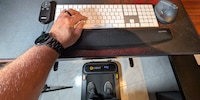

How the MFT Challenge Disc 2.0 performs in the physiotherapy practice
A wobbly disc ensures stable muscles and time flies by. The med&motion physio team tested the Challenge Disc 2.0 in practice and found out: The smart training device is surprisingly old-fashioned in one respect.
"I'm the competitive type, I quite like it," says Ramona, who has just got off the MFT Challenge Disc 2.0. It was her first session on the balance trainer. A movable disc that, in conjunction with an app, sets balance tasks, provides small games and gives feedback on exercise performance. Ramona is undergoing rehab at med&motion in Zurich after tearing her cruciate ligament. Lous de Haart is looking after her and has seen many motivated patients on the disc in recent months. "Most of them say that time flies when they train with it," says the physiotherapist. So a time machine that effortlessly takes you to a fitter future? It's not quite that simple. Together with her colleagues, Lous took a close look at the Challenge Disc.
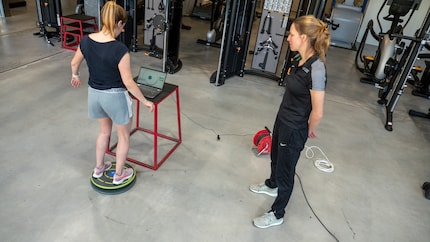
The technology
Underneath the disc is a tilt sensor that communicates with the connected PC, Mac, smartphone or tablet via Bluetooth Low Energy. Before I hand over the brand new test device to med&motion, I try it out myself and experience the annoying side of "Low Energy": the built-in battery is dead as a doornail. Fitted with a fresh button cell (CR 2032), everything then works as it should.
A short tap wakes up the challenge disc, which is then recognised in the app. The disc calibrates itself with every new connection, which is why it must be placed flat on the floor and nobody should be standing on it at the start. I tried it out on a MacBook and iPad, at med&motion the application was installed on Windows. "The software is very easy to use and the connection via Bluetooth always works quickly," says Lous. As long as your device supports Bluetooth Low Energy and is not running completely outdated software, you shouldn't have any technical problems. If in doubt, you can check compatibility here.
The app: MFT Bodyteamwork
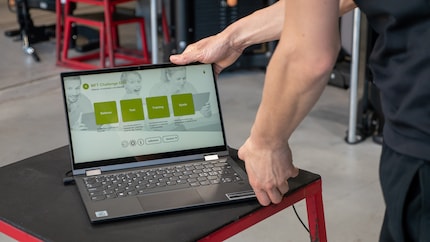
MFT Bodyteamwork is neither a graphic masterpiece nor packed with countless functions, but it is very clear. The app was developed with advice from the Institute of Sports Science at the University of Innsbruck. You can choose between "Balance", "Test", "Training" and "Games". In the first mode, you are left to your own devices and can check your balance on a kind of target, in the centre of which you have to hold a point that reacts to your movements. If you complete the coordination test, you will learn about your strengths and weaknesses. It includes tasks in different axes and combined forms of movement.
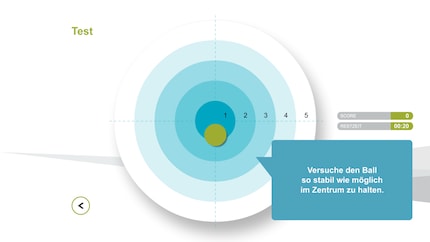
Shift your weight forwards and backwards, from left to right, diagonally and in a circle. If you perform the exercises with one leg, you will get comparative values for the coordinative performance of your legs. The smaller the difference, the better for you and your joints.
The app then gives you a recommendation as to which level you should start your training at. A higher level means that the target range you need to aim for is smaller. In one of the five training programmes, you complete different exercises one after the other, interrupted by short breaks.
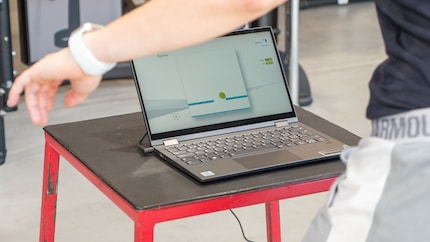
When you start a game, the visuals change, but not the underlying task. Instead of chasing a point, you steer a small skier through gates or a ball to the finish line by shifting your weight. You can enter your results in a leaderboard.
Feedback from the physios and patients
After we've briefly looked at the basics together, I let Lou and her physio colleagues use the Challenge Disc 2.0 for several weeks before I ask about their experiences. Here are the most important points
Pro
- The patients are challenged in 3D movements
- The motivation is high, it's fun
- Easy to use without much instruction
"Most of the other aids I use only have one direction of movement or are freely movable, such as a Bosu ball," explains Lous. With the Challenge Disc, she can determine very specifically in which direction there is a deficit. "That's really good and also unique to this device." It's not just knee patients who benefit from the exercises. The Challenge Disc is also used for foot, hip and back problems as well as for coordination training for athletes without complaints.
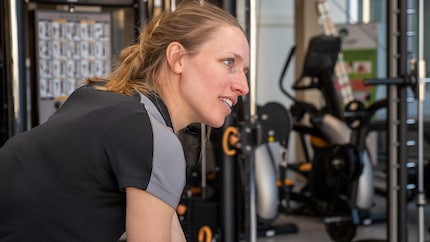
Contra
- The training exercises are too short, the duration cannot be customised
- Resistance cannot be adjusted, too difficult for children to shift their weight
- Training data is difficult to save and manage for different patients
"Most training exercises only last ten to 15 seconds until the break, which is a little short for stability exercises," says Lous, summarising his experience. This feedback has also come from patients. "The games last one minute and forty seconds. That's great. It would be nice if you could set the training duration." The second point of criticism could also be solved with a software update: "You can't save the data of different patients," says the physiotherapist. "To document progress, I would have to write everything down." Or download it as a PDF. That's irritatingly old-fashioned for a smart device. There is no appealing internal presentation like any better fitness app offers.
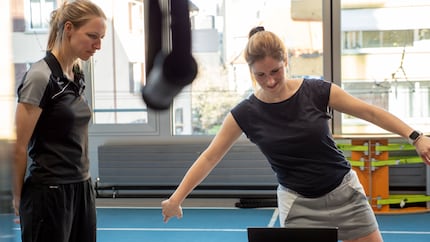
Conclusion
One of the strengths of the Challenge Disc 2.0 is that it works so simply and does not require thousands of parameters to be configured. "With just a few instructions, the patient can carry out the training independently," says Lous. "This means that the Challenge Disc is used much more often than a complicated device." The hurdles are so low that nobody is put off by it. The principle doesn't just appeal to young clients like Ramona, who needs to stabilise her knee after tearing her cruciate ligament. "Older people like it too," Lous has observed. "The patients enjoy it."
Training with the Challenge Disc 2.0 is entertaining and motivating. It also helps to localise weak points and eliminate them in a targeted manner. On the one hand. On the other hand, it wouldn't be difficult to give users even more options and let them customise the exercises to suit their own preferences. Or to present the interesting data in an appealing way. "It would be nice if you could find the individual test results somewhere," says Lous. If you train on your own and only occasionally use your own high score or the test programme as a guide, you won't miss it. Data disciples and physio professionals, on the other hand, will. What remains is a good balance trainer with even more potential on the software side.

Simple writer and dad of two who likes to be on the move, wading through everyday family life. Juggling several balls, I'll occasionally drop one. It could be a ball, or a remark. Or both.
